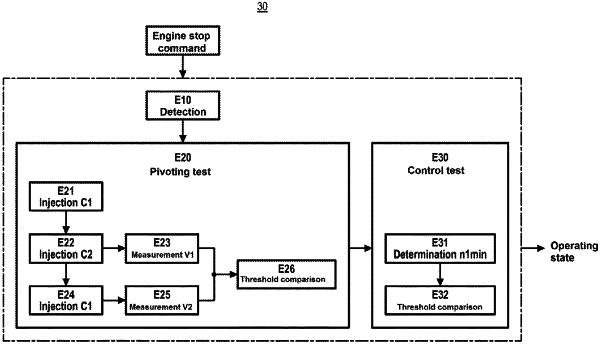| CPC F01D 17/26 (2013.01) [F01D 17/16 (2013.01); F01D 21/003 (2013.01); F02C 7/22 (2013.01); F02C 9/20 (2013.01); F02C 9/54 (2013.01); F05D 2220/323 (2013.01); F05D 2220/329 (2013.01); F05D 2270/03 (2013.01); F05D 2270/44 (2013.01); F05D 2270/64 (2013.01)] | 7 Claims |

|
1. A method for monitoring an operating state of a system for positioning variable-geometry members of a turbomachine, said system comprising the variable-geometry members actuated by at least one hydraulic actuator associated with an electrohydraulic member current-controlled by a computer, a power of said hydraulic actuator depending on hydraulic liquid pressures and on a current applied to said electrohydraulic member, said variable-geometry members being configured to travel over an operating range comprising a first position P1 and a second position P2, and
the method including during a deceleration phase following a command to stop the turbomachine:
a) a pivoting test implemented for hydraulic liquid pressure conditions that are determined and constant at limits of the actuator, the pivoting test including:
determining the first position P1 of the variable-geometry members;
applying a command C2 allowing controlling the actuator and bringing the variable-geometry members to the second position P2, the application of the command C2 including an injection of a second constant control current, determined according to a value of an equilibrium current of the actuator;
measuring a pivoting time from the first position P1 to the second position P2 and determining a first pivoting speed V1 from the first position P1 to the second position P2;
applying a first control command C1 allowing bringing the variable-geometry members to the first position P1, once the variable-geometry members have arrived at the second position P2, the application of the command C1 including an injection of a first constant control current, determined according to a value of an equilibrium current of the actuator;
measuring a pivoting time from the second position P2 to the first position P1 and determining a second pivoting speed V2 from the second position P2 to the first position P1; and
determining an anomaly in the operation of the positioning system of the variable-geometry members if the first pivoting speed V1 is less than a first determined speed threshold and/or if the second pivoting speed V2 is less than a second determined speed threshold,
b) then a control test including:
applying a strictly monotonic position setpoint of the variable-geometry members depending on a speed of a gas generator of the turbomachine and determining a minimum speed of the gas generator for which the position setpoint is satisfied; and
determining an anomaly in the operation of the positioning system of the variable-geometry members if the minimum speed is greater than a determined threshold value of the speed of the gas generator.
|